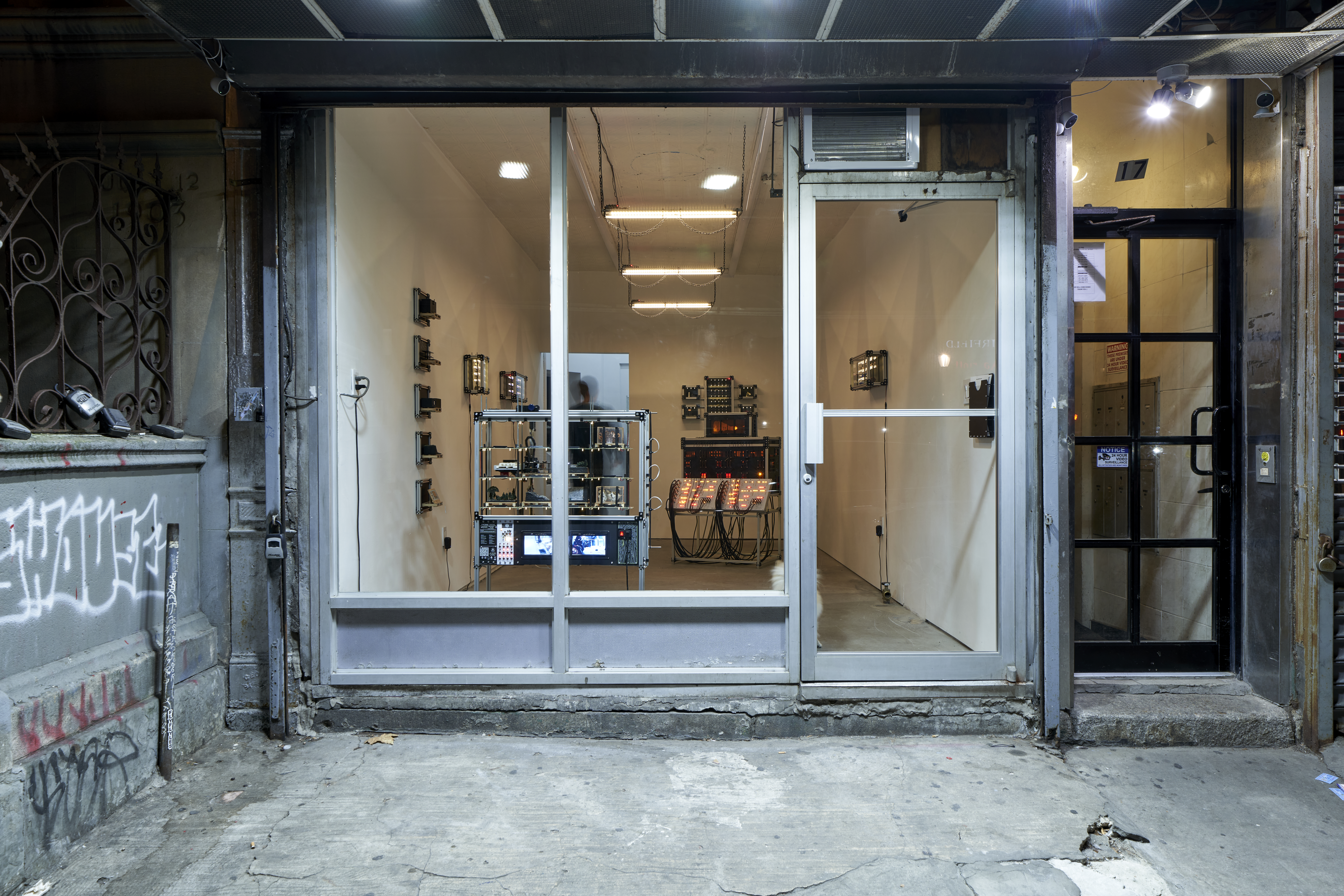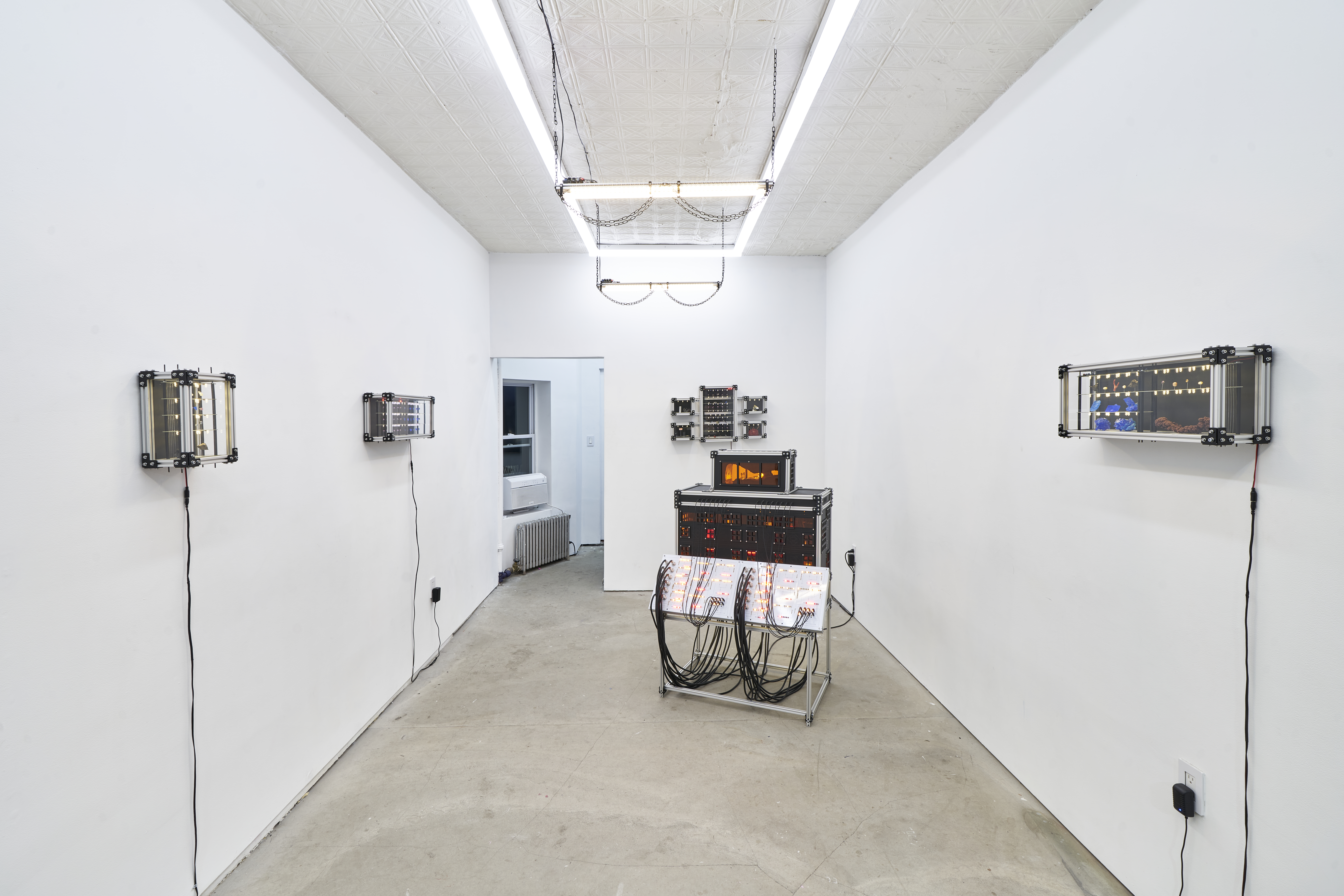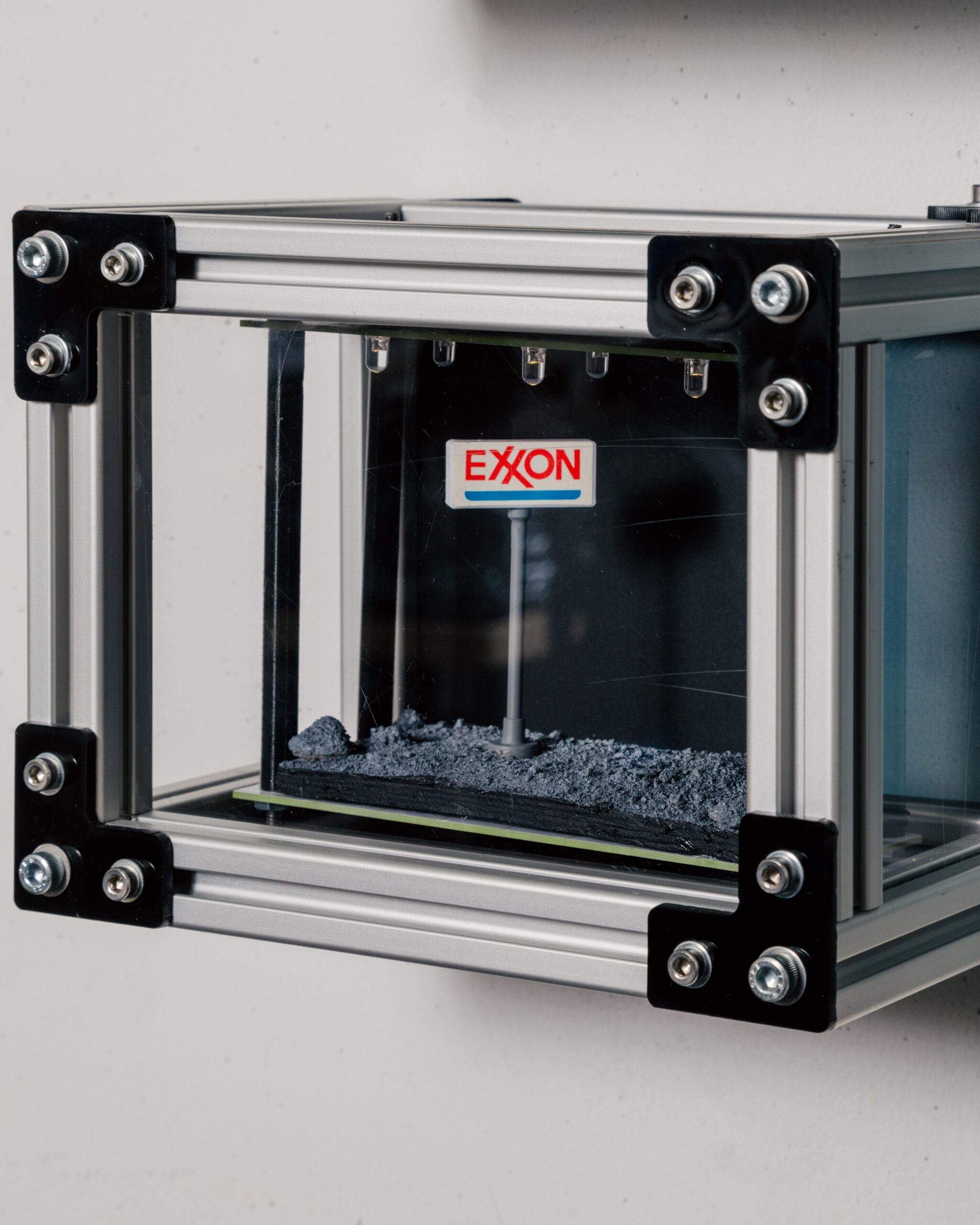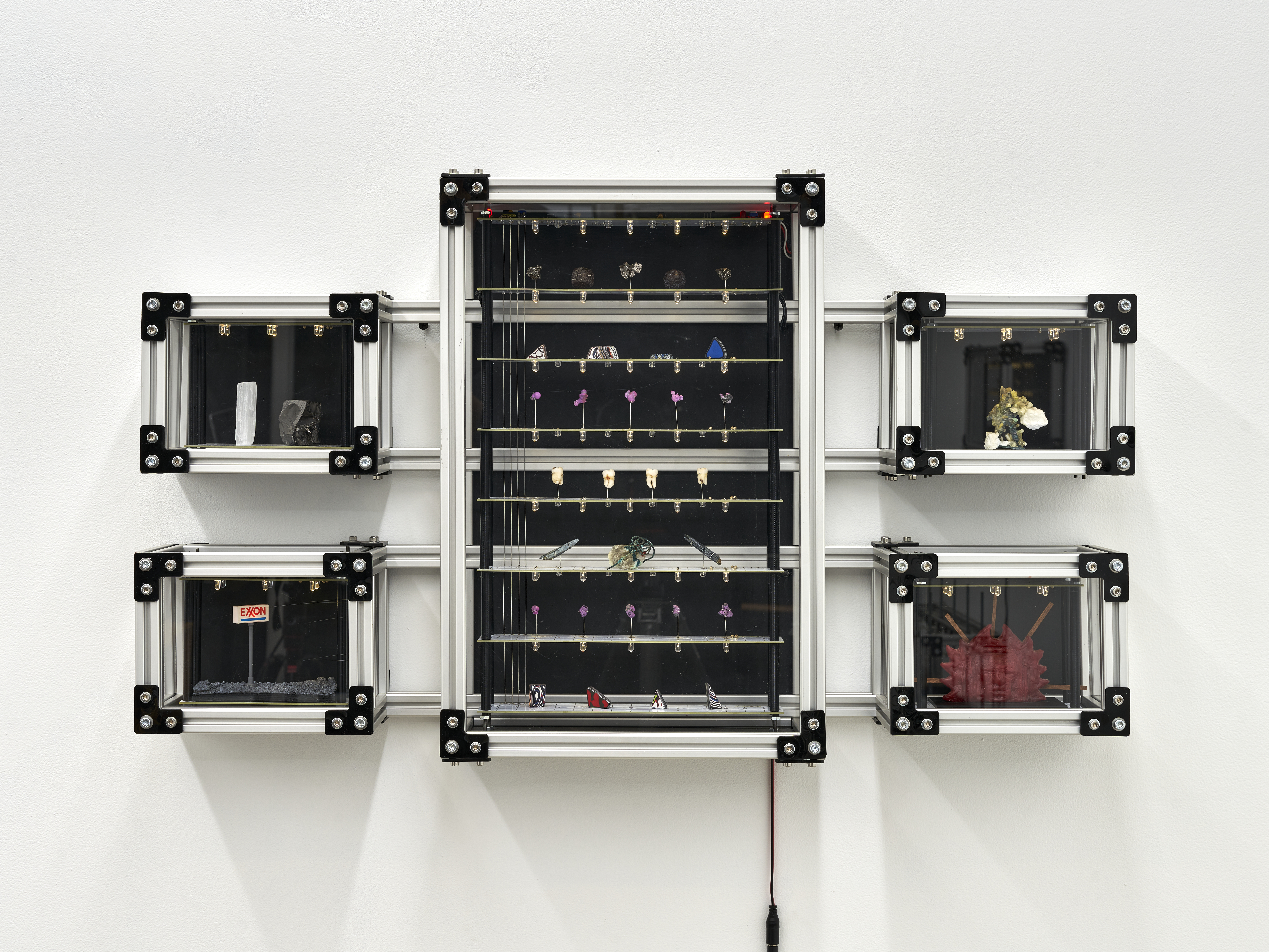Brian Oakes, photographed by Eric Helgas.
Without realizing it, I’d been observing Brian Oakes assemble works for his current show SEED, now on view at Blade Study, for months. Given the intricate nature of his sculptures, which involve complex wiring, circuit boards, and laser-cutters, I was convinced something insidious was going on. But upon seeing the works in the warm light of the gallery, I noticed the ways Oakes’ wonderfully weird sculptures reflect manufacturing and logistics systems, using dioramas and display cases to highlight those processes. The two standouts of the show include ASRS 1, 2024, a sorting machine that rearranges itself on a loop, and Encryption Device 1, 2024, a sculptural metaphor for Platos’ Cave that involves lava lamps and uses binary data processing to light itself up. Last week, shortly after his opening, I met the artist at the gallery to talk dioramas, “fedora guys,” and why pressing buttons is compulsive.
———
SANDSTROM: The first thing I want to tell you is that I’ve actually been watching you make these for some time, because you share a studio with my best friend.
OAKES: No way.
SANDSTROM: Every time I walked by I was like, “Is that the Unabomber in there? Is this a sculptural manifesto?”
OAKES: That’s so funny.
SANDSTROM: Do you get that a lot? Do people think you’re–
OAKES: The Unabomber?
SANDSTROM: Yeah.
OAKES: Specifically, yes. I’ve been getting that for years. In undergrad, I would get that all the time.
SANDSTROM: Yeah. Well, RISD has been known to–
OAKES: Produce Unabombers?
SANDSTROM: Yes. Anyway, I realized I first met you outside Silke Linder maybe a year ago through a friend. When we left they were like, “You’ve got to check out that guy’s work. He makes these fucking crazy-looking lamps, but they’re not lamps and they’re not light fixtures.” I think I’ve been following you since then, and obviously this show is a departure from those lamps.


Installation view of SEED. Photo by Kunning Huang.
OAKES: Oh, yeah. This was definitely a big pivot from the lamps. I was doing them for a couple years, and I wanted to try out some new things. I came up with some ideas for early parts of how these might work. It was around that time, about a year and a half ago, that I was getting to know Ian and Brooke of Blade Study a lot better. I admired their program, and they were showing some other artists that I was huge fans of.
SANDSTROM: Who in particular?
OAKES: Harris Rosenblum, Ryan Decker, Genevieve Goffman, Steward [Bird].
SANDSTROM: I guess doing something as specific as you do, it must have been cool to see a space where that would make sense for your work.
OAKES: Exactly. I felt like they were really hitting on this thing that I was excited about. They approached me about doing a solo show and were like, “What if for the first four months of designing the show, you try to not do any of these lamps?” I had already told them that I was interested in experimenting more with machines and processes, different materials outside of just circuit boards. It’s so rare outside of an institutional context that you get homework like that. Honestly, if they hadn’t pushed me, the show would’ve looked very different. But this has been the scariest thing for me, doing such a hard pivot on the kind of work that I feel like people were getting to know me for.
SANDSTROM: Well, it seems like it paid off. I wanted to ask about your decision to make these diorama-esque models.
OAKES: Yeah. First off, it’s incredibly cathartic to make a miniature. It’s so much fun, and that alone was enough to captivate me. Also, the way people latch onto abstraction, it’s almost a Rorschach test where people give you what they think it is. But with miniature, you work with more literal intention or context and image. You get to contextualize and build out a little bit more of what the conversation is. One thing I really wanted to work on, especially with this sorting machine, were these moments of almost schizophrenic projection: “Oh, these things are sitting next to each other in a specific way, and this is a machine that’s constantly rearranging.” You have these really nice moments of association where when you see two images next to each other, and you as a viewer get to decide if those belong or don’t because you’re kind of projecting a logic onto a system that’s obfuscating its own decision-making process.
SANDSTROM: You’re kind of like Willy Wonka.
OAKES: That’s funny, I haven’t gotten that before.
SANDSTROM: What’s the reaction been to the show?
OAKES: A lot of people get really excited about the cave. I had one person say it was a Socrates cave, which I thought was funny. It’s still this mythical kind of thing that means a lot to certain people, but also means nothing at all. Saying Socrates’ cave means the same thing as saying Plato’s cave to me. I was really drawn to the metaphor because I think it’s such a funny premise to be posed by a big philosophical mind or whatever. Some people think that when this kind of metaphorical construction was proposed, it was to be like, “Oh, this is why we philosophers are so grand,” because leaving the cave is understanding and learning that philosophy.

ASRS 1, 2024. 34″ x 15″ x 50″. Photo by Kunning Huang.
SANDSTROM: Yeah.
OAKES: It’s kind of giving fedora guy, and I think it’s just a funny thing to zoom in on.
SANDSTROM: Also, what are these supposed to be?
OAKES: They’re supposed to be more options for this sorting system.
SANDSTROM: Oh, cool.
OAKES: I always knew that there was maybe only going to be six or seven on here, but I made 40. This was a way to expand the vocabulary a little bit more outside of the show context. It’s kind of literal like that, because there’s also supposed to be this back and forth of where along the process you are. This process of sorting and logistics, it’s supposed to be happening behind the scenes and be this seamless thing, whereas the display cases almost scream, “Look at me!” There’s supposed to be a transition between those two modes of viewing.
SANDSTROM: The Exxon box is my favorite. I’m wondering what else you built that didn’t make it into the show?

Detail from Display Case 1 (A Body), 2024. 5” x32” x19”. Photo by Kunning Huang.
OAKES: Well, the miniatures are supposed to look at imagery that is charged from a mundane, everyday lens. One thing I really like about the Exxon sign specifically is that it’s part of a display case that has a changing light system, so it sort of just slowly cycles through a warm light, a UV light, then a combination of the two, and then totally dark. When it goes totally dark, the only light that stays on is the Exxon sign. I grew up in Jersey in the suburbs, and for some reason whenever there’d be a storm and the power would go out, the gas station always had power. It’s this funny thing I noticed, that the thing that controls all the oil has all the power. I also wanted to incorporate miniatures into the displays in some way to tie a through line through everything. This one is a model of the room that we’re in right now. This is Blade Study.
SANDSTROM: Woah, I would not have guessed that. That’s cool.
OAKES: This is us right now, we’re sitting right there. This was one that I wanted to put a little second art show inside of. Ryan Decker had a show here earlier this year, and he did a lot of 3D printing for his show. He makes full one-to-one 3D models of everything he does, so I was really trying to convince him to 3D print me a miniature of his show and then I could put them all in here and reset up his show.

Installation view of SEED. Photo by Kunning Huang.
SANDSTROM: That would have been awesome.
OAKES: I think that could have been a fun one. Another one was, there’s this type of diorama called a Handsteins or something like that, but basically it’s when you own a mine, you take a chunk of that raw refined ore and you build a whole diorama of the mine and the miniature on it. It’s supposed to be a display of your wealth because it’s like, “This is a chunk from my mine,” and it’s building dioramas on chunks of earth or ore or something. They’re really beautiful. So I was trying to make one of those out of a really big crystal that I grew.
SANDSTROM: You grew them?
OAKES: Yeah. I grew a lot of the crystals in here. I had one really large chunk that I was trying to build a diorama on, and it just kept falling apart because it’s really hard to attach things to crystal structures, especially when you’re not in a climate-controlled environment and the humidity in the room makes them melt essentially. It gets too hot. It also is kind of heavy, so it wasn’t super conducive to a machine like this that isn’t the most powerful.
SANDSTROM: Do you 3D print?
OAKES: I 3D print a lot of stuff. I also laser-cut a lot of components on these. A lot of the mounts are all custom 3D-printed parts that I made. I outsourced a few of them to friends that had better printers than I do.
SANDSTROM: When you put this show up, did you immediately get back to the studio? Were you flooded with ideas?
OAKES: I definitely have some more ideas for display cases that I really want to do. I do have another idea for another sorting machine, but I just need to take a break for a minute. This show was insane, and I also installed a bunch of work at Pretty Garden where we did the after-party.
SANDSTROM: Yeah.
OAKES: I also had the biggest piece I’ve ever made that’s up right now at R & Company as part of their Objects: USA triennial. It’s a seven-and-a-half diameter spiky lamp piece. I had to produce that this summer, and this show, so now I’ve kind of been taking a break. But I definitely have a bunch of new ideas. The obvious one is I’d want to make a really big display case, a six-foot-by-six-foot full wall big thing.
SANDSTROM: One critic likened your work to Chris Burden’s Metropolis sculptures, and then I realized that actually what I wanted to ask is if you’ve seen Megalopolis.
OAKES: I haven’t yet. I was going to see it the other night. Have you seen it?
SANDSTROM: No, I’ve been putting it off.
OAKES: I’ve heard mixed things. My roommate just saw it and he actually said it was bizarre, but he liked it, so I don’t know.
SANDSTROM: I’m hearing really mixed things too. Are there any other artists working in this medium that you really admire?

Encryption Device 1, 2024. Photo by Kunning Huang.
OAKES: Yeah. I adore Jon Kessler’s work, and I’ve been studying it forever. Mark Dion is another artist that I love who actually just had a show around the corner at No Gallery. I feel like the way that he talks about museums as an institution that can be critiqued or represented in such a specific way with his display cases and cabinets of curiosity style was definitely a big inspiration for my display cases. Also Taylor [Ashby Hawkins], who has a show up at Ashes/Ashes right now. He actually came by with Jon Kessler one day when I was doing a repair, so I chatted with him for a bit and John Kessler was like, “Kinetic work, it’ll break your heart. No matter what you do, it will always break your heart.”
SANDSTROM: Oh, woah.
OAKES: I was hoping for some encouragement, to hear that it gets easier. He’s just like, “No.”
SANDSTROM: That’s really funny. I was just in L.A. a couple of weeks ago and I saw that show at Jeffrey Deitch, Post Human.
OAKES: Oh, yeah. That show looks great.
SANDSTROM: It had that insane Paul McCarthy sculpture of those men fucking the forrest.
OAKES: Oh my god.
SANDSTROM: Yeah. There were kids running around it and I was like, “Oh, no.”
OAKES: What a freak.
SANDSTROM: Yes, yes. Have people tried to touch this work, and has it stressed you out?
OAKES: Some people have asked me if this sort of interface is interactive because it kind of resembles a modular synthesizer. Every time they ask me, I ask them what they would touch. There’s no knobs. Do they just want to unplug a cable? I mean, I understand the impulse. Something about lights and buttons is extremely tantalizing. But I stopped putting knobs on my pieces because people would touch them.

Display Case 1 (A Body), 2024. 5” x32” x19”.
SANDSTROM: I can understand that.
OAKES: I see that as more of a failure on my end, because if you put a big red button on it, of course someone’s going to want to touch it. Years ago when there was the Robert Rauschenberg retrospective at MoMA, I took my grandparents. There was one series of works that he made that was crushed cars hanging on the wall, and one of them had a big red button on it. I read the description out loud to my grandpa, and I was like, “Oh, yeah. It says that button is still hooked up to the original car horn, so when it’s pressed the car horn goes off.” My grandpa’s like, “Oh, no way” and just presses the button, and then a security guard came and yelled at us. I was like, “That’s valid.”
SANDSTROM: That is valid.
OAKES: If you put a big red button on this, and you put it on the wall at chest height, of course somebody’s going to press it.

